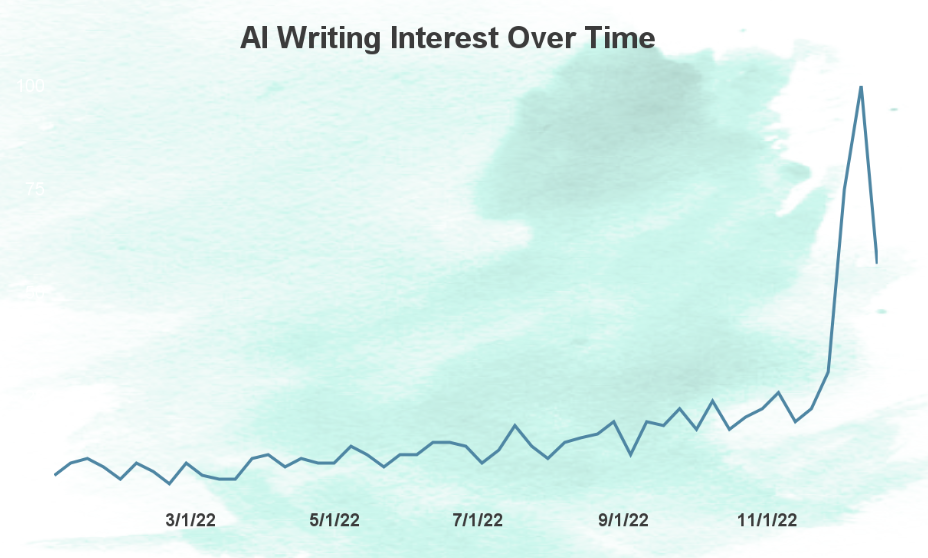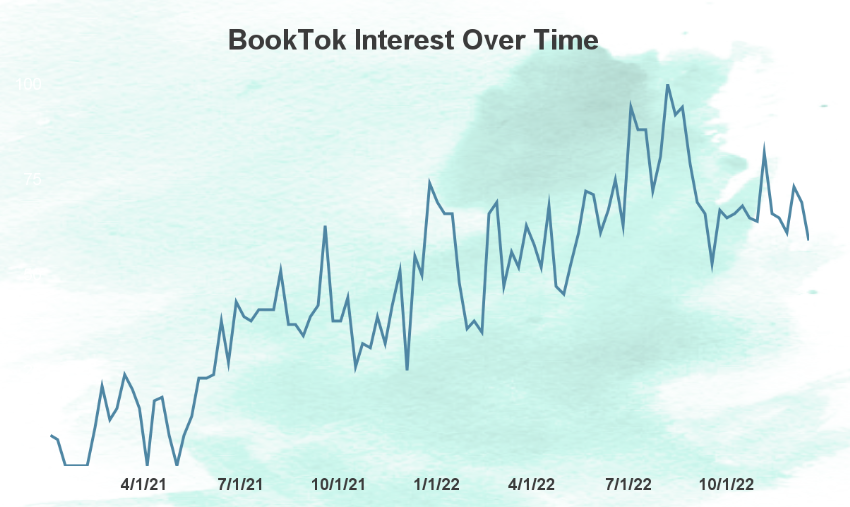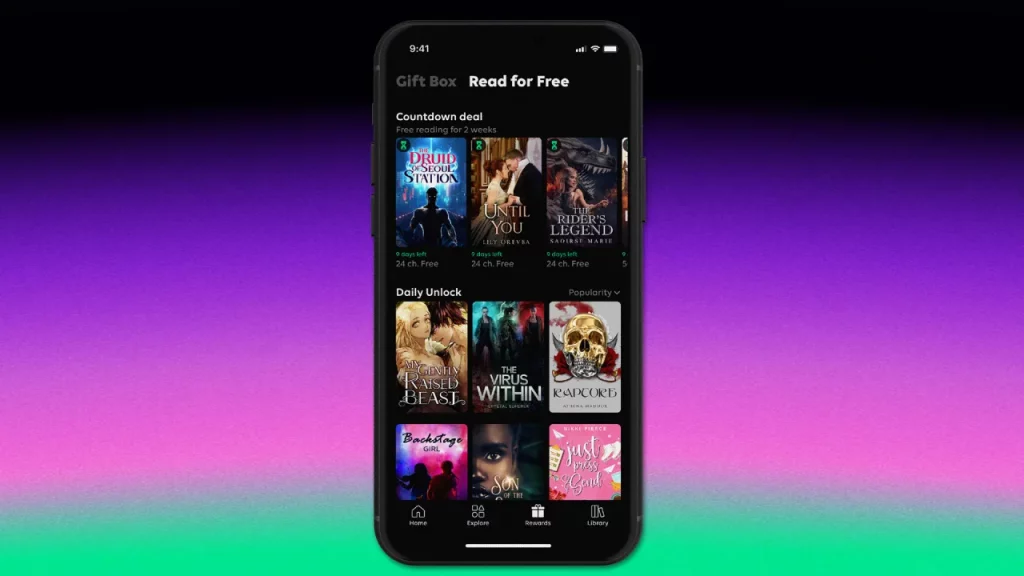Publishing trends appear and take hold fast. Often before you even notice.
Every year we survey publishing industry experts and analyze our own data to make predictions on what the new year has in store for authors and the wide world of publishing. Here are our top ten publishing trends to watch in 2023.
If you’re new to Written Word Media, welcome! We provide easy-to-use and effective book marketing tools for authors. We’re known for our large reader audience (over 1 million and counting!) and our friendly customer service. You can join our free community of over 20,000 authors here.
Click here to see all of our products and services, or contact us to ask how we can help you sell more books.
Click the links below to jump to the publishing trend you want to read first, or scroll to read them all.
- Artificial Intelligence Gains a Foothold In Writing
- AI Art Gains Steam
- AI Narrated Audiobooks Proliferate
- AI Drives Debate in the Publishing Industry
- New Formats and Serial Fiction Heat Up
- Advertising Automation is Embraced
- More Indies Embrace Direct Sales
- Indies Make the Most of Economic Changes
- Indies Focus on Global Audiences
- BookTok Matures
Publishing Trend 1: Artificial Intelligence Gains a Foothold In Writing
The artificial intelligence (AI) buzz has been around for a while, but the end of 2022 brought a sharp uptick in noise.

OpenAI’s release of ChatGPT in late November is perhaps the single largest contributor to the excitement, and a number of industry professionals see changes on the horizon for the publishing industry.
“I’m not the quickest adopter when it comes to AI, but I’m seeing things now in both design and writing that are starting to show real promise,” wrote Mark Dawson of the Self Publishing Formula.
“2023 will be the year of AI writing,” wrote Bryan Cohen of Best Page Forward. “But it won’t mean that the ‘robots’ will take over the bestseller list. Authors will use AI tools like Sudowrite as part of their regular process to blow past writer’s block and create more books in less time.”
Joanna Penn agrees that AI will be used to assist writing of all kinds of writing in 2023.
“We will also see more adoption of generative AI tools as part of the creative and marketing process,” wrote Penn. “The opportunities for creators just keep expanding!”
Generating marketing copy, participating in a brainstorm session with an AI tool, rephrasing existing copy; all of these use cases are viable now. But what’s the long game?
“Whether you like it or not, AI-written books are coming,” wrote Craig Martelle, author and 20Books organizer. “Not one-button-simple books, but from paragraphs to pages to chapters written with refined prompts and detailed outlines.”
“If I were to train an AI, I could use some eight million words from just my books,” wrote Martelle. “I wouldn’t need anyone else’s voice to fill in gaps. With the possibility of indistinguishable prose on well-thought-out story lines, this is a logical next step for many.”
What this means for authors:
Bottom line, in 2023 more authors will use AI tools to assist their creative process. Not everyone will, and this publishing trend will not be controversy free (keep reading, we’ll get to it). But for some, these tools will lead to a real boost in productivity.
Publishing Trend 2: AI Art Gains Steam
AI writing will gain a foothold in the publishing industry in 2023, and we see the same coming with AI visual art. Most publishing professionals’ expertise is in the written word. And, while many are talented visual artists as well, more design tools will be a welcome addition for many others.
“Authors can take advantage of AI Art by using it to produce concept art of their work, create advertising images, generate logo ideas, and even produce art for use in book covers, comic books, and children’s books,” wrote Dave Chesson, Kindlepreneur. “While I don’t believe AI Art is quite at the level where it can produce Book-Cover-level artwork, I have no doubt that the level of quality will get there eventually, given the rate of advancement we have seen in 2022 alone.”
Jane Friedman of the Hot Sheet agrees that AI art is in a position to expand within the publishing industry in 2023.
“For years now, there’s been talk of how AI will upend all kinds of professions, yet the technology has never really progressed to the point where I felt it merited much attention in the writing and publishing community,” wrote Friedman. “That’s changing fast, and I expect that 2023 may be the year that a lot of dominoes start falling.”
“AI-generated art is coming for book covers and custom illustrations,” wrote Friedman.
The demand for affordable visual art in the publishing industry makes the rise of AI art tools a compelling publishing trend for authors and publishers alike. To learn more about AI art tools, read our post on AI art and how authors can use it.
What this means for authors:
The available AI art tools are very fun, so they are worth playing with for that reason alone. But, don’t expect to AI to instantly create the book cover of your dreams. Human designers are highly knowledgeable in what sells, and they are much easier to convey your vision to. AI art may be better suited to assisting your creative process or book marketing than gracing the cover of your books right now.
Publishing Trend 3: Audiobook Creation Becomes Easy
AI is going to play a big role in audiobook narration in 2023. Google already has an AI narration tool for authors. And we think AI narrated titles could soon fill the gap between authors who can afford human narration, and those that can’t.
Apple is also now offering AI narration, and, as Penn mentioned on her Twitter feed, how far behind do we think Audible and ACX will be?
No, AI narration is still not close to the quality and emotion of a human narrator, but for some genres it works quite well. And, as long as the AI narration is made clear up front, some readers will prefer AI audio to no audio at all.
What this means for authors:
AI narration will not replace human narrators anytime soon. However, AI narration is a cost effective way to add another format that readers may enjoy. Consider creating an AI narrated audiobook in 2023 and see how it does.
If you already have plans to work with a human narrator, don’t cancel. AI isn’t going to get you close to that quality.
Publishing Trend 4: AI Drives Debate in the Publishing Industry
Enough beating around the bush. We see big things coming for the publishing industry and AI in 2023, but this technology does not come without a hefty ethical debate.
AI systems are trained by reading the web and other published works. They consume incredible amounts of information, and use these inputs to generate their outputs. So, in a way, many AI tools are a product of collective humanity.
So, who owns the outputs from AI tools? Who SHOULD own the outputs of AI tools? These legal and ethical questions will test publishing and many other industries in 2023, and almost all our industry professionals agree.
“I predict that the hostility, infighting and divisiveness we’ve seen regarding the use of A.I. tools in general has the potential to become more divisive than the long-standing ‘Wide VS Exclusive to Kindle’ debate,” wrote Mark Leslie Lefebvre of Draft2Digital.
“There are those who fear what A.I. will do to the creative community – displace artists, narrators, writers,” wrote Lefebvre. “And there will be those who acknowledge that A.I. is another tool in the arsenal that writers will be able to employ as part of their author business.”
Beyond the ethical debate, which, by its very nature, is unlikely to ever be settled, expect to see the courts getting involved in 2023.
Book Brush CEO, Josh Wiley believes the legal debate will provide some clarity with time.
“With an exploding market of available AI art, I foresee more regulation and court-decided copyright decisions to provide better direction for anyone on the fence,” wrote Wiley.
Jane Friedman agrees.
“I expect legal challenges to start appearing, with some very tough questions to be answered about ownership of IP—both the IP used to train these models and the IP produced by them,” Wrote Friedman.
So the debate will heat up in 2023, but almost everyone we asked also preached calm when thinking about the rise of AI.
“As with any emerging disruptive technology, there is always a rough adjustment period,” wrote Chesson. “And as with any technology, there will be people who take advantage of them in nefarious ways. But overall, I think authors and artists will be helped rather than hindered by these advancements.”
Lefebvre counsels authors to avoid falling into the mindset of traditional publishers who have not evolved with the industry.
“I caution writers from spending more time worrying about this technology’s effect on the creative world than figuring out ways to adapt it into their process. I ask them to remember something critically important: The reason indie authors have dominated so effectively in the indie author space is they saw something with the advent of eBooks that the larger, more established traditional publishers couldn’t see. They saw possibility. They saw new ways of getting their work into the market. They saw open doors, infinite reach, and the ability to bypass the gatekeepers of traditional publishing,” wrote Lefebvre.
Cohen agrees that fighting against the inevitable may not be the best choice for all authors.
“There will be plenty of critics who question whether or not a book partially generated by artificial intelligence should be allowed on amazon,” said Cohen. “But those who ignore the debate and consider the potential benefits may see a massive boost in productivity from using the software.”
What this means for authors:
Focus on enjoying the debate. People will have different, but still valid, opinions on the use of AI. We all stand to learn a lot from productive discussion.
Publishing Trend 5: Authors Expand into New Channels
In 2023, authors will continue to find new ways to grow and diversify their revenue. From serial fiction to NFTs and Substack, there are more ways than ever for authors to get creative about increasing their earnings.
Orna Ross, founder of the Alliance of Independent Authors, believes conditions are ripe for authors to find new income streams.
“The creator economy, in which fans directly fund creators, including authors, is already booming and is set to grow in 2033, with more creator economy platforms like Patreon, Podia and Substack emerging,” wrote Ross.
Serial fiction has been around for a while now, but with the entry of Yonder into the marketplace in late 2022, signs are that 2023 could be a big year for indie authors.
Written Word Media announced a partnership with Yonder in October 2022.
“In the past 3 months we have paid out thousands of dollars in advances to Written Word authors as part of this partnership”, Ferol Vernon, COO of Written Word Media reports. “This is exciting because this revenue is additive for authors; it’s money in the bank that they would not have otherwise received.”
Serial fiction and other formats stand to gain ground as authors look for more ways to generate revenue from their intellectual property.
“Serial fiction is a great way to repurpose backlist content that is tropey and fast-paced and to find an entirely new audience for it,” said Emma Boyer, VP of Operations at Written Word Media.
We also see the popularity of serial fiction increasing with readers in 2023. Younger readers are more likely to read on their phones, and we expect serialized formats, like Kindle Vella and Yonder, to take advantage of this device preference.
The buzzy new startup, Books.io, is looking to help authors monetize NFT collector issues of their work. If successful, this is another example of how authors will be able to supplement their income from new sources.
The demise of Twitter and Facebook may accelerate the trend towards direct reach. Authors tend to win when middlemen lose power, and the decline of platforms like Twitter and Facebook, could translate into direct gains for authors.
What this means for authors:
New channels mean more opportunity, but also more distraction. Instead of letting FOMO dictate your choices, evaluate each opportunity with regard to your capacity.
Will this channel generate sales for you? Will you enjoy doing it? Do you have the time to do it? These are all great questions to ask.
Publishing Trend 6: Advertising Automation Is Embraced
Facebook and Amazon advertising are integral parts of many authors’ marketing strategy, and this will no doubt continue in 2023.
However, authors looking to get the most out of their advertising will need to adapt to changes from the platforms and be open to trying new tactics.
In 2022, Facebook Ads saw a host of changes, one of them being the removal of a large portion of interest targeting options.
Dramatic changes like this are something many Facebook advertisers have come to expect and it’s safe to say that similar changes could occur in 2023. Authors can embrace automated solutions to stay ahead of this publishing trend.
“Facebook is becoming much more efficient at finding and then serving the perfect audience for each advertiser,” wrote Mark Dawson. “Interest targeting is still powerful – and certainly the easiest way to get your ad out there – but, for the last 18 months or so, some of the best options have been removed and I’ve pivoted to trusting the algorithm with things like lookalike audiences.”
“It’s not perfect, and a good amount of manual handholding is still required, but I’m seeing steady progress and better rates of conversion,” wrote Dawson.
Dawson is seeing a similar trend on Amazon and is getting good results by putting more trust in its suggested campaign setting.
“This is also the case with Amazon, and using automated campaigns to find readers who are interested in your books at the precise time that they might be tempted to try them,” wrote Dawson.
What this means for authors:
Installing the Meta pixel on your website and building your email list to start building lookalike audiences is more important than ever. Test these audiences in combination with interest targeting on Facebook, and don’t be afraid to test more heavily automated campaign options across platforms.
Publishing Trend 7: More Indies Embrace Direct Sales
Last year Cohen and Lefebvre predicted that direct sales would continue to grow as a significant channel for indies, and they were spot on. Cohen sees this publishing trend expanding even more in 2023.
“With more education and lower barriers to entry, even more authors will take the leap into direct selling in 2023,” wrote Cohen. “But I expect even Amazon-exclusive KDP Select users will dip their toes into the waters by selling their paperbacks and their audiobooks on their websites. This tactic will allow them to get Pages Read while they start collecting more email addresses through platforms like Shopify and WooCommerce.”
Direct sales make sense for indies on a monetary and philosophical level. Nothing is more indie than writing, publishing and selling your books all on your own.
Kinga Jenetics, CEO of Publish Drive, believes selling direct offers both freedom and security for indies.
“Selling direct is going to continue to be a hot place for growth in a savvy author’s business plan,” wrote Jenetics. “These direct connections will allow authors to build and engage their reader base without relying on outside companies or tools.”
One benefit of direct sales is the amount of data they give to authors. When a reader buys a book from Amazon, the author won’t know who they are. But, when they buy a book from a Shopify store, the author receives all of the purchase data.
This data allows authors to effectively target their readers, and send them the right message at the right time.
Direct sales mean more data and revenue for indies. Yes, the setup can be onerous, and those with smaller readerships may not see the benefit yet, but we see this channel continuing to grow as more authors recognize its benefits.
The publishing industry will also move to support direct sales in 2023. Written Word launched Limelight in 2022, a dedicated email promotion that allows premium members to link directly to their website, shopify store or social media account. The promotion has been popular with authors who are actively looking to move more of their revenue mix toward direct sales. We anticipate more products like this proliferating in 2023.
What this means for authors:
More direct sales marketing products means authors with smaller audiences could benefit from selling direct in 2023. If you already have a store, consider how you can maximize royalty free revenue.
Can you release titles on your Shopify store before they are available elsewhere? Would this lead to more revenue? Or would it hinder your rankings on the big retailers when you publish there?
Publishing Trend 8: Indies Make the Most of Economic Changes
There is widespread anticipation of an economic recession in 2023, and indie authors are poised to make the most of it.
“The fear is that readers will spend less money on books,” wrote Ricardo Fayet of Reedsy. “While this may sound like dire news, it also means that readers will look at prices more than ever to inform their book-buying decisions — and price has long been one of the most effective marketing tools for indie authors.”
Readers cutting back means more consideration for lesser know authors with cheaper titles, and more readers looking for a bargain instead of snagging the new bestseller.
“I expect price promotion strategies, as well as book promotion services like Bargain Booksy or Freebooksy to become even more effective in 2023,” wrote Fayet.
Discount books aren’t the only way for authors to win in the face of economic headwinds.
“While we can expect readers to think twice about buying a $9.99 ebook from a traditional publisher, it’s unlikely that readers will cancel their Kindle Unlimited or Scribe subscriptions — which allow them to read unlimited books every month for that same amount,” wrote Fayet. “If you are wide and distribute to libraries, a further strategy could be to remind your readers that they can access your ebooks for free via their library apps — thus supporting a retail channel that is both budget-friendly for readers, while still paying you full-price royalties upon checkout.”
What this means for authors:
A recession could lead to an increase in demand for low-cost entertainment, and you can’t get a better bang for your buck than an indie eBook. Consider the pressures your readers are feeling when you advertise, price, or distribute your books in 2023. What options do you have to reach readers? What message will be most effective?
Publishing Trend 9: Indies Focus on Global Audiences
Expanding to new markets is a great strategy for indies to grow efficiently, and Jenetics sees a big year ahead for indies and new markets.
“Publishers and authors will be looking more thoroughly at where they spend their money, as well as how they can grow their audience across a global market more quickly and efficiently,” wrote Jenetics.
Part of why 2023 is shaping up for a big year in international sales is the growth in markets across the world.
“Asia, the Middle East, and Latin America are all showing global growth according to the data we see on the PublishDrive platform,” wrote Jenetics. “Many authors don’t know that Asia is the biggest market for books behind the US, and for the last several years, annual growth rates are the highest in this region.”
Publishing in new markets presents a big opportunity, and we see indies embracing international distribution at higher rates than ever in 2023.
What this means for authors:
Distributing your work to international markets could be a big opportunity. The number of english-language readers across the globe is higher than you might think, and getting exposure in these developing markets could set you up for success later on.
Publishing Trend 10: BookTok Matures
BookTok is massive. As of late December 2022, the hashtag had close to 97 billion views on the platform, and it’s not showing any signs of slowing down.

2022 also saw large publishers get in on the game as Barnes and Noble and others partnered with TikTok to generate buzz around their titles.
TikTok also has plans to begin selling books on the platform. Could TikTok itself become a competitor to Amazon in 2023?
In 2023 we see even more indies investing in BookTok and spending more marketing time and budget on the platform.
We also expect larger publishers to refine their approach on the platform and develop even deeper partnerships.
Oh, also, you can follow Written Word Media on TikTok!
What this means for authors:
Even if TikTok isn’t for you, authors should still investigate it as a marketing channel. Posting isn’t the only way to use the platform. Can you work with an influencer to promote your books on TikTok? Are your readers on TikTok and can they review your books for you? BookTok is too big to be ignored completely in 2023.
Conclusion
There you have it. Our top 10 publishing trends for 2023. From AI’s big year and the controversy that will follow it, to new formats and international markets, there’s a lot on the table for authors and publishers alike.
What do you see coming in 2023? Which trends most excite you or worry you? Let us know in the comments below.


How about books in a language other than English? Say, French? Are any of those new or expanding platforms cater to other languages?
good question, how about Italian?
It will be helpful to new-comers if the text would spell-out the meaning of KDP, FOMO, NFT ACX on first use.
Hi Rachel. That’s a great point, we’ll definitely keep this in mind for our future posts
I am a unique author. 97 years old, my marbles still functioning. Lived and traveled all over. Specialty visiting communist countries, USSR (Coast to coast, arctic to south), Peoples Republic of China, East Germany, Checkoslovakia, Hungary, Arrested by FSB had to sign confession. World War two US Submarine veteran (Sunk 17 enemy ships and one radar station) .Seed in Finnish National Guard before US Navy. Written one Submarine adventure novel and one memoir .Professionally edited by KAA. How do I get published?
Patrick, hope you’ve had luck publishing. If not, go to Amazon and publish. Watch YouTube videos to help.